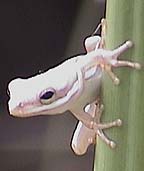
Green Treefrog
Hyla cinerea
Description:
- adult sizes range from 1-1/4 to 2-1/2 inches
- the female is larger than the male
- it tends to match the color of the object it's on but not always (some color variations are shown in the photos above and at the right); usually colors range from shades of green to a putty brown, but other colors include reddish-brown (center column, second photo) and blue
- it is most easily identified by white "racing stripe" down the side; sometimes the stripe has a dark border and sometimes it doesn't
- it also has white on back of rear legs (center column at right, third photo down) and tends to have whitish "lips" and a whitish underside
- it can change color quickly but the stripe is the same color; in rare occasions, the stripe may be minute or missing
- sometimes the back appears to have small yellow "flecks"
- toepads are medium sized and observable (photo above) unless the frog is at rest position (right column, first photo)
- the tympanum is greenish to green-brown while the Squirrel Treefrog's tympanum is more brown to bronze
Food:
- small insects including crickets, beetles, moths, caterpillars
 Call:
Call:
- regular call
- a ringing quenk-quenk
- males call approximately 75 times/minute during mating season
- from a distance sounds almost cowbell-like
- calls most frequently prior to rain or on humid evenings, especially when barometric pressure is dropping
- when males call to attract females, usually on vertical branch no more than 2-3 feet above water surface
- usually call from April through late October
- call higher pitched than Cuban or Squirrel Treefrog
- rain call is a single, high-pitched bark
- mp3 (recorded by Ralph Arwood)
Habitat:
- on plant stems, in trees and shrubs near water
- stays relatively close to the ground
- most active at night
Range:
- entire state of Florida, and elsewhere in the Southeastern United States
Breeding:
- can breed toward end of first year
- breed late spring to early summer
- breed in water at least several feet deep in permanent ponds (most other frogs breed in shallow temporary ponds created by rainfall)
- female lays small masses of eggs on roots of floating vegtation; egg mass forms and grows as it absorbs water, eventually appearing jelly-like just below water surface
- eggs black to very dark brown and white
- eggs hatch in 4-6 days
- tadpoles to about 1-1/2 inches, greenish, long pointed tails, usually with creamish stripe from nostril to eye
- tadpoles change into frogs in about two months, usually from July to early October

























![]()

